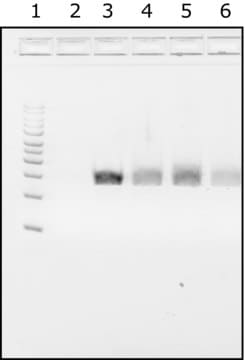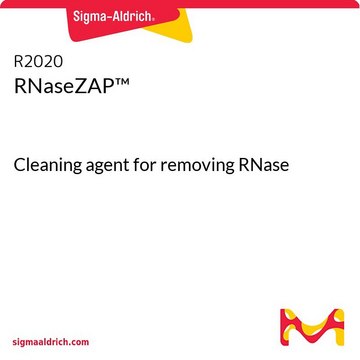W1754
Agua
PCR Reagent, suitable for PCR
Sinónimos:
H2O
About This Item
Productos recomendados
Nombre del producto
Agua, PCR Reagent
densidad de vapor
<1 (vs air)
presión de vapor
3 mmHg
esterilidad
sterile-filtered
Formulario
liquid
envase
vial of 1.5 mL
técnicas
PCR: suitable
índice de refracción
n20/D 1.34 (lit.)
pH
5-7
bp
100 °C (lit.)
mp
0 °C (lit.)
densidad
1.000 g/mL at 3.98 °C (lit.)
actividad extraña
DNase, none detected
RNase, none detected
cadena SMILES
O
InChI
1S/H2O/h1H2
Clave InChI
XLYOFNOQVPJJNP-UHFFFAOYSA-N
¿Está buscando productos similares? Visita Guía de comparación de productos
Categorías relacionadas
Descripción general
Aplicación
- as a component of the reaction mixture and as a diluting agent in microfluidic RT-qPCR
- as a component of the reaction mixture for the amplification of products from fungal (Trametes versicolor) DNA
- as a diluting agent and as a component of the reaction mixture for the amplification of cDNA
- Water has been used to make up the final volume of the sample in polymerase chain reaction (PCR)
Idoneidad
Otras notas
Código de clase de almacenamiento
12 - Non Combustible Liquids
Clase de riesgo para el agua (WGK)
nwg
Punto de inflamabilidad (°F)
Not applicable
Punto de inflamabilidad (°C)
Not applicable
Equipo de protección personal
Eyeshields, Gloves
Elija entre una de las versiones más recientes:
¿Ya tiene este producto?
Encuentre la documentación para los productos que ha comprado recientemente en la Biblioteca de documentos.
Los clientes también vieron
Artículos
The introduction of small interfering RNAs (siRNAs) into cultured cells provides a fast and efficient means of knocking down gene expression and has allowed siRNAs to quickly become a ubiquitous tool in molecular biology.
Introduction of small interfering RNAs (siRNAs) into cultured cells provides a fast and efficient means of knocking down gene expression and has allowed siRNAs to quickly become a ubiquitous tool in molecular biology.
Protocolos
Protocol describes amplification of DNA through quantitative PCR with SYBR Green. Consistent batch-to-batch performance can be achieved with large numbers of PCR reactions.
Protocol using hot start dNTPs. Method includes modified nucleoside triphosphates that block DNA polymerase nucleotide incorporation during hot start PCR to increase specificity. Compatible with a variety of PCR reagents.
Protocol for high fidelity amplification of long PCR fragments up to 22kb from complex DNA mixtures and up to 40kb from simple DNA mixtures. AccuTaq LA.
Reverse transcription (RT) is the process of converting RNA to cDNA using a reverse transcriptase enzyme and dNTPs.
Nuestro equipo de científicos tiene experiencia en todas las áreas de investigación: Ciencias de la vida, Ciencia de los materiales, Síntesis química, Cromatografía, Analítica y muchas otras.
Póngase en contacto con el Servicio técnico
![Agua, calidad para PCR liquid, pkg of 25 mL (03315959001 [1 x 25 ml]), pkg of 25 mL (03315932001 [25 x 1 ml]), pkg of 100 mL (03315843001 [4 x 25 ml])](/deepweb/assets/sigmaaldrich/product/images/326/208/bac83eed-3c88-4738-b4b5-50d3b223dd1c/640/bac83eed-3c88-4738-b4b5-50d3b223dd1c.jpg)


